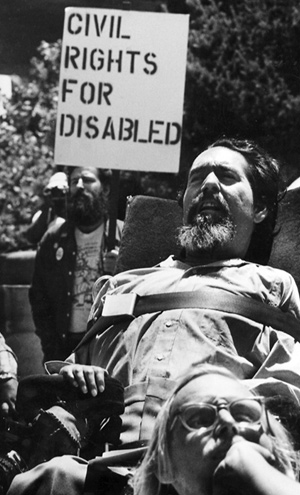The History of the Independent Living Movement

The Independent Living (IL) movement started in the early 70s when the Berkeley Center for Independent Living in California was founded by Ed Roberts and others with disabilities who were attending the University of California at Berkeley. Ed, who was a post polio quad, was living in a hospital and was required to be back in his room by 10 PM. He was denied the right to make many of the basic decisions college students took for granted. So Ed, with the help of some federal funding, started the first Center for Independent Living (CIL). The Center focused on assisting people with disabilities to live in the community with whatever supports they needed.
The creation of the Center started a national movement. In 1978 the federal Rehabilitation Act was amended to include Title VII which for the first time provided federal funding for the development of a national network. Why did the changes occur and what was their genius? The answer was relatively simple; it was the birth of a new model: the medical model vs. the community model; the medical model sees people with disabilities as the problem and the Independent Living model sees people with disabilities as the solution. The medical model focuses on the physical or mental problem that needs to be “fixed” where the community living model focuses on the individual with a disability as the solution and not the problem. Through peer support, advocacy, skills training and information and referral, Independent Living Centers across the country now provide services to hundreds of thousands of people with disabilities each year.
The philosophy of the Independent Living Movement evolved from the Community Rights Model which espouses the belief that if an individual needs supports to live in the community then these supports should be provided. In 1999 The Olmstead Decision by the Supreme Court supported this aspect of the philosophy based on the Americans with Disabilities Act. Independent Living also believes in the right to risk taking and the right to fail as part of the learning process. Through peer support people learn from each other how to problem solve and live more independently.
Today there are over 400 Independent Living (IL) Centers throughout the US that practice the cross disability philosophy: the belief that all people with disabilities share a common thread that brings them together. Centers are private not-for-profit organizations that are run by and for persons with disabilities. The staff must be at least 51% persons with disabilities and the nonprofit board must be at least 51% persons with disabilities. Massachusetts has 10 Independent Living Centers (ILCs) located throughout the state. To view the ILC’s based in Massachusetts, please click on the following link: Massachusetts ILCs. Last year the Centers in Massachusetts served over 12,000 persons with disabilities. Independent Living Centers are not places to live rather they are agencies which provide information, support and advocacy to support people with disabilities to live in the communities of their choice.
Today IL Centers are the cornerstone of individual and systems advocacy for disability issues throughout the US and continue to expand into local communities around the nation.
Once persons with disabilities were spit upon and pitied. Today the Disability Community has made much progress in overcoming these negative attitudes and because of the IL and disability rights movement, individuals with disabilities are part of mainstream society. However, there is still much to be done. Too many persons with disabilities are institutionalized in nursing facilities and want to leave. But because of the Independent Living Centers, more and more individuals with disabilities are moving back to the community based on their choice and not a decision made by the medical system.
To read more about the History of the Independent Living Movement, please click the following link: Independent Living Movement History
